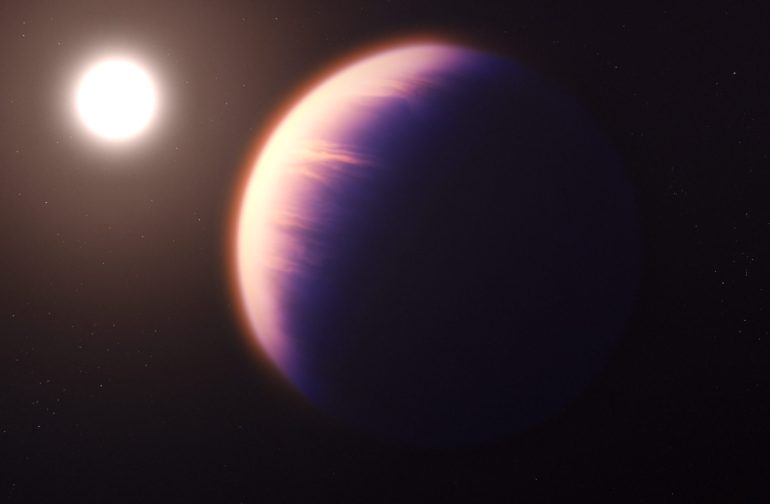Astronomy’s most advanced eye is proving its mettle: Using the new James Webb Space Telescope (JWST), astronomers have uncovered the gas envelope features of an exoplanet with unprecedented detail: “Hot Jupiters” WASP Flickering in the light streaming through 39 b’s atmosphere, their chemical composition was reflected in detail. The information has already made it possible to draw conclusions about photochemical processes and even the planet’s formation history. The demonstrated performance potential of JWST now gives hope for more exciting applications. Scientists say that outer atmosphere research may one day even provide evidence of life.
In recent years, many reports of astronomical discoveries ended with the remark: “More insight may soon be provided by the planned James Webb Space Telescope”. We are now in this new era of astronomy: the first images and spectra published in mid-July 2022 have already generated excitement. They illustrated the JWST’s enhanced performance compared to telescopes available up to that point: it could look much deeper into the universe, image astronomical objects with an entirely new level of detail and better characterize light spectra. can break from These were the results of the “Early Release Science Program”, which consists of sub-projects initially intended to explore the JWST’s basic functionality and capability for its planned research purposes. One of the most important is studying the atmospheres of exoplanets.
JWST provides more “perspective”
WASP-39b is the target of planetary research groups that are part of the Transiting Exoplanet Community of the Early Release Science Program. It is about 700 light-years away from us and belongs to the category of “hot Jupiter”. Although it is only about the mass of Saturn, it is 1.3 times larger in diameter than Jupiter. Its extremes are related to its temperature of about 900 °C. Because WASP-39 b orbits its star very closely in just four Earth days. Astronomers chose it to test the JWST because its puffed atmosphere is particularly well suited to the process of transit spectroscopy. Insight into the characteristics and composition of the gas envelope is possible through a “rainbow-like aberration” of light that shimmers through the gas envelope as a distant world passes in front of its host star.
Astronomers in the transiting exoplanet community used the JWST to observe four separate transits of WASP-39b in mid to late July 2022. In August, scientists had already announced the detection of carbon dioxide in WASP-39b’s atmosphere. They now present further results, which are divided into five publications. In it they report on a breakdown of the chemical composition of WASP-39b’s atmosphere and the importance of the results on investigations with the Webb telescope’s spectrographic instruments NIRCam and NIRSpec and NIRISS-SOSS.
evidence of photochemistry
Of particular interest is the explanation of an initially intriguing abnormality in the spectrum of twinkling light. This turned out to be a signature of sulfur dioxide, which has now been detected for the first time in an exoplanet atmosphere. Its special thing is that it is a substance that is produced by photochemical processes similar to ozone in the Earth’s atmosphere. As the researchers explain, the sulfur dioxide molecules are formed when the outer reaches of the exoplanet’s atmosphere interact with the star’s high-energy radiation. Photons form hydroxyl radicals (OH) from abundant water molecules (H2O). Chemical reactions then occur with the participation of hydrogen sulfide (H2S), which lead to the formation of sulfur dioxide (SO2). “This is the first unambiguous photochemical product detected in the atmosphere of an exoplanet,” the scientists write.
Some of the new information also reflects aspects of planet formation: combining information about certain proportions of matter in WASP-39b’s atmosphere with planet formation models and knowledge of our Solar System enables conclusions to be drawn. In particular, the ratios of carbon to oxygen, potassium to oxygen and sulfur to hydrogen indicate that the collision of small planetary precursors formed the celestial body, the researchers explain. In particular, the fact that oxygen is much more abundant in the atmosphere than carbon, they say, suggests that WASP-39b originally formed far from its star and only later moved into its near orbit. .
look to an excited future
Above all, though, the scientists see significant value in their results: They make their experience with JWST use available to the astronomical community and offer “recipes” for dealing with the data set. This should make it easier to use the telescope for further transit observations like this one. “The new data represent a turning point,” emphasizes Natalia Batalha from the University of California at Santa Cruz, who coordinated the current observing program. His colleague Laura Kreidberg from the Max Planck Institute for Astronomy in Heidelberg continues: “These early observations are a foreshadowing of all the results that can be expected from JWST. We put the telescope through its paces and tested its performance. The observations were almost error-free – even better than we expected,” says the astronomer.
The researchers say the current results are also a step on the way to one of the ultimate goals of exo-atmosphere research: that certain signatures in the gas envelope may one day provide evidence of extraterrestrial life forms. The present investigation serves as a testbed for observational techniques that may be used in such searches in the future. In addition, a basic understanding of exoplanet atmospheres is important for being able to distinguish between the atmospheric characteristics of exoplanets with and without the involvement of living organisms when searching for life, astronomers say.
Source: Max Planck Institute for Astronomy. The results were published as a five-part series of articles on November 22, 2022 in the journal Nature.

Internet fan. Alcohol expert. Beer ninja. Organizer. Certified tv specialist. Explorer. Social media nerd.





